Australian Pulse Bulletin
Lentils: Planning for high quality markets
Key points
- Avoid the causes of poor colour in lentil seed coat and kernels by eliminating some of the causal problems before harvest starts.
- Harvest lentils as soon as ripe, to avoid harvesting, lodging and weathering problems.
- Avoid soil, stone, cereal and other lentil variety contaminants at harvest and during handling.
- Avoid any storage situations that may allow mould to taint the sample with an unpleasant odour, rendering it unacceptable for market.
To deliver quality lentils that meet current receival standards and market requirements, growers must concentrate on management factors well before the harvester enters the paddock. Focus on choosing the right variety, strategic use of fungicides, and attention to harvest details such as croptopping. The harvester does need to be set up correctly—but this is the last link in the overall management chain. The condition of the crop before harvest and harvest timeliness are just as important.
Variety choice may also affect market acceptability, and can influence susceptibility to external factors that may downgrade grain quality. So select varieties with disease resistance characteristics that suit your conditions. Small sized red lentil types (e.g. PBA Hurricane XT, PBA Bounty) are acceptable in major export markets. Medium sized types (e.g. PBA Ace, PBA Bolt and PBA Blitz) are also widely sought because of their size and seed coat colour. Larger sized types (e.g. PBA Jumbo2) are well regarded for their size and colour. New domestic and export markets are being further developed following the release of several green lentil varieties including PBA Greenfield, a medium seeded lentil and PBA Giant, a large seeded green lentil.
While seed size and colour (determined by variety) influence quality, sound management is needed from seeding to delivery to avoid shrivelling, seed discolouration, breakage and insect damage. Discoloured and small, shrivelled lentils will be down-graded from human consumption quality, and if retained as seed for sowing the next year’s crop may result in poor emergence and vigour.
Lentil downgrading
Seed staining in lentils can be caused by:
- late rain on maturing or mature crops
- varieties susceptible to ascochyta blight (AB) are more prone to discolouration
- if not controlled, botrytis grey mould (BGM) can downgrade quality severely
- frost
- exposure of the seed due to pod splitting
- genetics—high tannin grains are more likely to discolour due to aging
- poor storage conditions, including high moisture or exposure to sunlight
Note that colour of both the lentil kernel (cotyledon) and seed coat is assessed at receival points. Growers will need to have kept foliar diseases under control, and avoided premature desiccation of the lentils, and/or unduly delayed harvest.
There is nil-tolerance of any unpleasant odour in lentils, such as that caused in poor storage conditions.
-
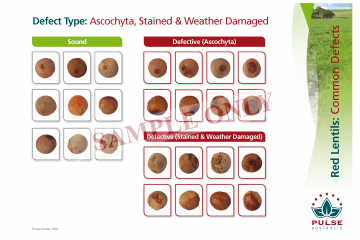
Red lentil: Ascochyta, stained and weather damaged defects
-
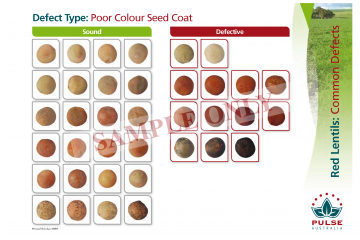
Red lentil: Poor colour seed coat defects
-
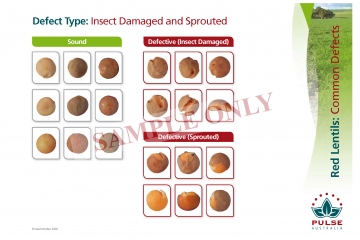
Red lentil: Insect damage and sprouted defects
-
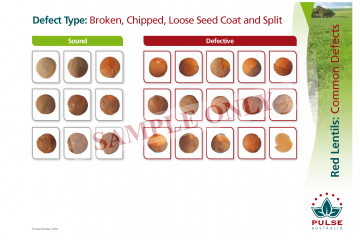
Red lentil: Broken, chipped, loose seed coat and split defects
-
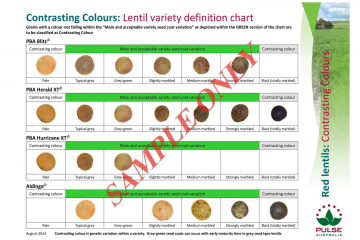
Red lentil: Contrasting colours – lentil variety definition
Fungicides
Disease control starts and ends well before harvest. Ascochyta blight is a major cause of seed discolouration in lentils. Ascochyta resistant varieties such as PBA Herald and PBA Jumbo2 produce minimal ascochyta seed staining. More susceptible varieties such as PBA Bolt and PBA Jumbo might require strategic use of fungicides to prevent fungal damage of seed. Apply fungicide late flowering and prior to a rainfall event to reduce spread of the ascochyta fungus onto the seed pod and into the seed.
Seed can be dressed with seed treatment like thiabendazole and thiram (e.g. P-pickle T®) to minimise seed-borne transmission of disease. A protectant fungicide such as mancozeb or chlorothalonil applied at six to eight weeks after sowing is not often required. If weather conditions are conducive to disease development, a fungicide should be applied near completion of flowering. Early ascochyta control alone may not prevent seed staining occurring later in the season.
Seed staining can also be caused by botrytis grey mould (BGM) infection. Protection against BGM needs to commence just before canopy closure. Repeat applications may be required to protect new growth if disease conditions prevail.
Harvest management
As guidelines to improve management of lentil quality at harvest, it is recommended that growers:
- know the delivery standards for lentils
- monitor seed moisture (harvest just under 14% if possible)
- consider desiccation or croptopping for early harvest and to dry down the crop uniformly
- harvest as soon as possible
- ensure a correct header set-up
- minimise handling of grain
- maintain correct storage conditions.
Poor kernel colour is caused by premature ripening of the crop, either because of the season or by desiccation or croptopping too early. If in doubt, assess potential areas for poor colour before the crop is reapt, so that these areas can be avoided or reapt separately. Areas at greatest risk of poor kernel colour are those that were later maturing at desiccation, hence wheel tracks, low patches, specific soils in the paddock or frosted areas. At greatest risk of poor seed coat colour are the diseased areas. These are areas to look at initially before harvest.
Setting up harvesters to avoid sand and stone contamination in lentils is important for lentil harvest. Contamination can occur from crop lifters or stubble clumps, and travelling too fast is also a major cause.
Growers may need harvest into or across the direction of crop lay. Fitting screens or perforated bases under the platform auger and/or the broad elevator helps remove the dirt before it enters the header. Perforated covers on the cross auger and elevator boot helps sieve out sand. Leaving off the seconds cover avoids repeats and cuts out small stones. A perforated cover on the bubble auger and on the out-loader auger helps too. It is better that the problem be solved at the harvest stage, not later at the delivery point.
Delays in lentil harvest can lead to shattering or pod loss, lodging and poor feeding into the harvester, reducing harvest speed and increasing likelihood of soil contamination. Grain is also drier and more fragile, and more vulnerable to weathering if rain occurs before harvest. Delays may lead to quality issues with green lentils in particular.
Delivery standards
The maximum level of poor colour (discoloured) lentils is usually one per cent by weight each of poor colour seed coat and poor colour kernel. Poor colour lentils are those with disease or weathering blemishes. Maximum level of defective seeds other than poor colour is 3%. Defective seeds include all seeds with cracks, splits, damaged seed coats, as well as any insect damage. See also 'Receival standards'.
Avoid contaminants
Off-type lentil variety contamination can occur if the harvester and grain handling equipment is not cleaned out between varieties. Contamination of other lentil varieties in-crop must be avoided. See also 'Lentil variety cross-contamination'.
Similarly cereal grain contamination can occur, and the receival standard is only 2 cereal grains per 200g, so even low cereal plant numbers can cause a problem. Cereal plants in lentil crops must be removed in-crop before they set seed.
Monitor seed moisture
Harvest should commence when seed moisture reaches 13-15 per cent. At least 20 plants should be sampled at a minimum of six sites across the paddock. The first seed harvested should be kept for seed, as it has the highest moisture content and as such is less prone to harvest damage and should have a better germination percentage if stored and handled correctly.
Desiccation or croptopping
Uniform maturity assists timeliness and ease of harvest. Some lentils could be weedy, so desiccation or croptopping may be needed to make harvesting easier and on time. When paddocks are ripening unevenly, desiccation can help protect the early maturing parts of the paddock from weather damage whilst allowing the remainder of the paddock to mature.
Lentils should be desiccated when the crop has reached full maturity, generally when 50% of the crop starts to yellow. Desiccating too early may leave an unacceptable proportion of seeds with poor colour. The key indicator is when seeds in the top pods are firm and turning from yellow to red. Tips of the plant and upper pods are still green. The crop will be ready for harvest 2–10 days after spraying, depending on timing and weather. It is important to harvest before the plants become brittle.
Desiccation is to ensure uniform ripening of the lentils or to dry down any late maturing weeds. Croptopping is targeted at preventing weed seed set, so is done earlier than desiccation, with some potential loss of yield or quality if not careful. Some later forming lentil seeds will not be physiologically mature at the time of application, so could be vulnerable to having green kernel colour, hence poor colour, caused by premature ripening. Seeds may also be more wrinkled, shrivelled or stained in colour as a result of early croptopping. In practice croptopping is also a form of early crop desiccation since it does hasten crop maturity. The major differences between desiccation and croptopping are that:
- application timing is different and initiated by different criteria
- both can cause reduced grain quality and yield if applied at the wrong stage of maturity of the crop
- chemicals and rates for desiccation are higher than that required for croptopping
- croptopping will hasten maturity and harvest timing.
Glyphosate is not registered for seed crops and should not be used in pulses intended for seed production or sprouting.
See also 'Desiccation and croptopping pulses'
Header set-up
Harvester manuals provide a range of information to lentil growers including information on header set-up. Due to the some-what similar size of lentil seed to cereals, header settings may not be greatly different from wheat or barley. Lentil seed sizes differ between years and varieties. Adjust settings for the conditions of the day.

Minimise handling
Belt shifters are the recommended method of handling lentils as they can be damaged by auger flights. If an auger is used it should be run full and at a slower speed than for cereals. Augers with a gap between the flight and the barrel are less likely to jam.
Correct storage
The seedcoat of most lentils will darken over time, however the extent of this darkening will vary depending on the original seed coat colour and storage conditions. We could expect lentils to darken faster when stored in warm, moist conditions compared to cool, dry conditions. Under typical farm storage conditions, darkening of lentil seed can be expected to be slow enough that marketing can occur late into the next season. Lentils can also darken very quickly if exposed to sunlight, particularly if they have a light coloured seed coat like green lentils (e.g. Boomer) or Aldinga red lentils.
Lentils are best not stored in bunkers or in ‘sausage bags’ for any length of time as pockets of moisture can quickly lead to black, mouldy grain which can contaminate the remainder of product. Black, mouldy grain can also taint the sample with a most unpleasant odour, rendering it unacceptable for consumption.
See also ‘Grain bags for pulse storage’ and Storing pulses (Stored Grain Hub)
Key contacts
Disclaimer
Information provided in this guide was correct at the time of the date shown below. No responsibility is accepted by Pulse Australia for any commercial outcomes from the use of information contained in this guide.
The information herein has been obtained from sources considered reliable but its accuracy and completeness cannot be guaranteed. No liability or responsibility is accepted for any errors or for any negligence, omissions in the contents, default or lack of care for any loss or damage whatsoever that may arise from actions based on any material contained in this publication.
Readers who act on this information do so at their own risk.
Copyright © 2015 Pulse Australia
All rights reserved. The information provided in the publication may not be reproduced in part or in full, in any form whatsoever, without the prior written consent of Pulse Australia.
Last updated: 20 November 2015
